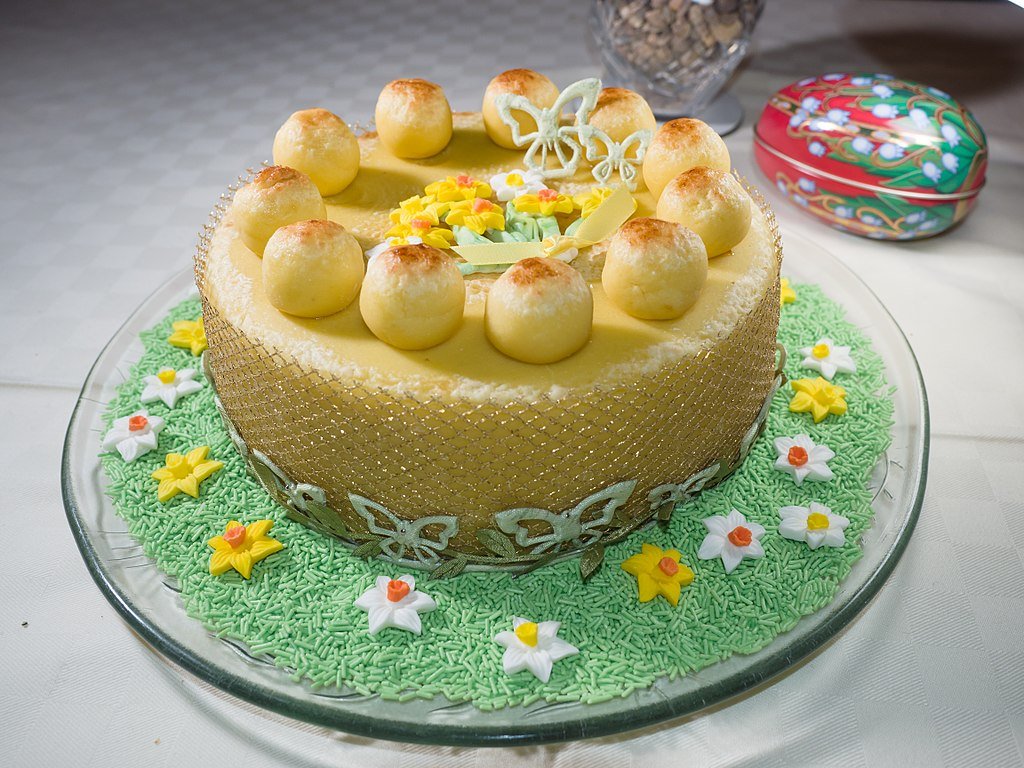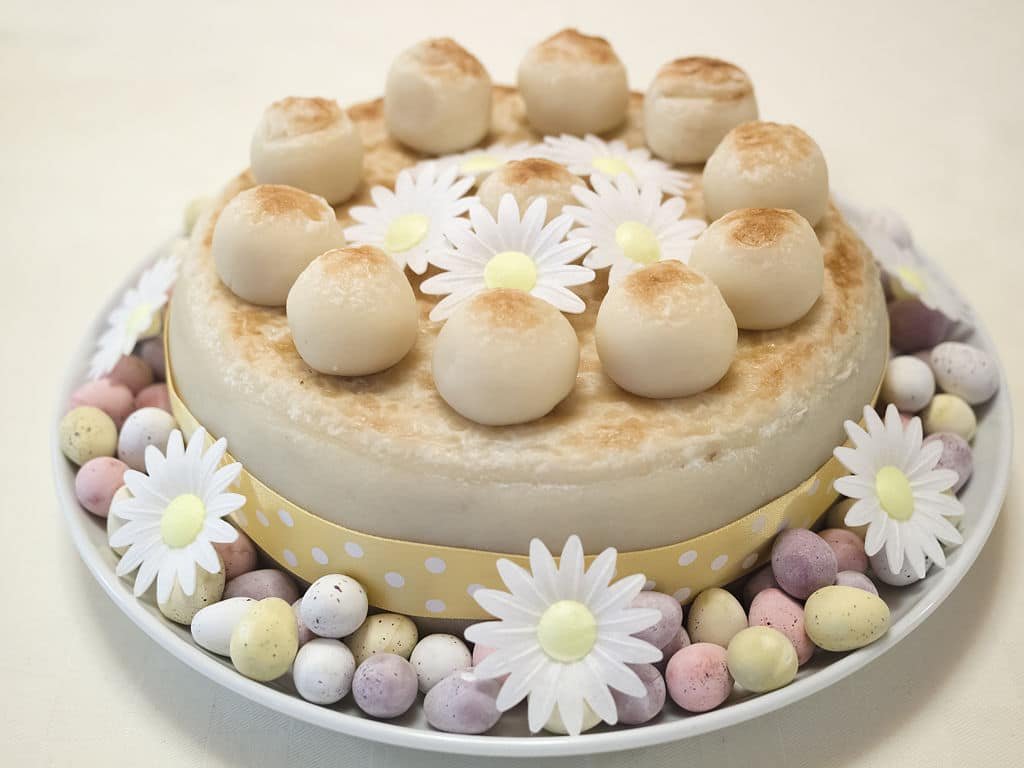
Simnel cake – a fruitcake with distinctive marzipan decoration. Most places I see it mentioned talk of it as an Easter cake, but I was sure I remembered learning about it for Mother’s Day in school. So which is it? Let’s find out.
What is Simnel Cake?
As mentioned above, simnel cake is a fruitcake that has been decorated in a very specific way with marzipan. There should be a layer of marzipan between the two layers of fruitcake. Another layer tops the cake. Eleven marzipan balls form a circle of decoration. The eleven balls represent the twelve apostles minus Judas. Occasionally, a cake will have twelve such marzipan balls, representing Jesus and the apostles (again, minus Judas). Additional (optional) decorations often take the form of flowers, chicks, and other Easter adornments.
Simnel Cake’s Origins
The simnel cake dates back at least to the medieval era and may have been boiled first, and then baked. Nobody is entirely sure where the name came from and so various stories have cropped up over the years. The most popular for several centuries was that Simon and Nelly could not agree how best to cook their cake, whether to boil or bake it. An argument ensued, followed by a compromise of doing both. Therefore the name of the cake is also a compromise. Cute but highly unlikely.
Another myth claims that the cake was the mastermind of Lambert Simnel, pretender to the throne in 1487… which would be all well and good if not for the fact that the simnel cake was being referred to some 200 years before this.
Still one more possibility is that the name comes from the Italian “simila” for a fine flour. A 1226 reference discusses making a simnel, i.e. a fine bread.
Mothering Sunday
Mother’s Day in the UK, also known as Mothering Sunday, bears no relation to Mother’s Day that is celebrated elsewhere in May. The British day is based upon the church calendar, falling on the fourth Sunday in Lent. (That means March 22, 2020).
So… Mother’s Day or Easter?
The fourth Sunday of Lent, in addition to being Mothering Sunday, was also traditionally referred to as Simnel Sunday. In many parts of the country, young domestics and maids would be permitted to visit their mother church and their families on this day, before the Easter holiday. This typically falls at the end of winter and in the early days of spring, and so food supplies might be running scarce. Thus, the young women might take some money or food with them. Historians have suggested that the simnel cake would be a welcome gift at this time. So if you associate simnel cake with Mother’s Day, you are correct.
However, over time, and presumably when there were fewer household servants but still people who wanted to enjoy the cake when they could, simnel cake became a more generalized Easter or Easter-period tradition. Many people now enjoy a slice on Easter Sunday. So if you associate simnel cake with Easter, you are also correct.

Simnel Cake Recipe
At this point, I would love to be able to share a picture of a freshly baked cake and regale you with my baking adventures. Since I am writing this during a time of sparse shelves and social distancing, I have been unable to make one this year. Below is a recipe to make your own courtesy of Traditional British Cooking by Hilaire Walden.
- 175g/6oz butter
- 175g/6oz brown sugar
- 3 large eggs
- 225g/8oz plain flour
- 1/2 tsp ground cinnamon
- 1/2 tsp nutmeg
- 150g/5oz currants
- 150g/5oz sultanas
- 150g/5oz raisins
- 75g/3oz glace cherries, cut into pieces
- 75g/3oz candied peel, chopped
- grated rind of 1 lemon
- 450g/1lb marzipan
- 1 egg white, lightly beaten
Preheat your oven to 160C/325F/Gas Mark 3. Grease and line with parchment paper a 7 inch round cake tin. Tie a layer or two of brown paper around the outside of the tin to help keep the marzipan from burning.
Beat the butter and sugar together and then slowly beat in the eggs. Fold in the flour, spices, dried fruits, cherries, mixed peel, and lemon rind. Mix well. Spoon half of the mix into the prepared baking tin.
Roll half of the marzipan out to create a round that fits into the cake tin. Lay it carefully over the cake batter. Carefully sppon the rest fo the cake mix on top of the marzipan layer.
Bake for 1 hour. Lower the oven temperature to 150C/300F/Gas 2 and bake for an additional hour and 15 minutes. At this point, check to see if it is cooked by inserting a skewer. It may need up to an additional 30 minutes of baking time. (I know this is vague, but recipes vary widely in their cooking time and better to check and add more time than to be stuck with a burned cake.)
After removing from the oven, leave the tin to cool for an hour before turning the cake out onto a wire rack. When completely cooled, brush the top of the cake with the beaten egg white. Roll half of the remaining marzipan into a round. Place that on top of the cake. Use the rest of the marzipan to shape into eleven balls. Use more egg white to fix them in place. You may also use a cook’s blowtorch at this point to carefully brown the cake, if you wish.
Happy Mothering Sunday to all the wonderful mums out there. And Happy Easter!



One thought on “Simnel Cake: For Mums or Easter?”
Comments are closed.